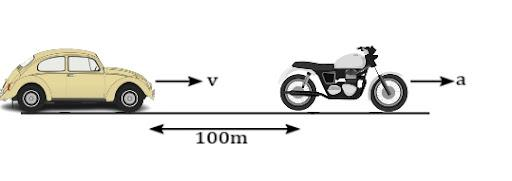
A man travelling in a car with a maximum constant speed of \[20\text{ }ms{{~}^{-1}}\] watches the friend start off at a distance 100 m ahead on a motorcycle with constant acceleration ‘a’. The maximum value of ‘a’ for which the man in the car can reach his friend is ?

A. $2\,m{{s}^{-1}}$
B. $1\,m{{s}^{-1}}$
C. $4\,m{{s}^{-1}}$
D. None of these
Answer
217.8k+ views
Hint:To do this question you have to know about Newton’s equation of motion. By applying the third equation of motion, we can solve this question. Here we have to find the maximum acceleration attained by the car to reach the bike. So, extreme conditions are also applied.
Formula used:
Here Newton's third equation of motion is used. Let a be the acceleration and u be the initial velocity and v be the final velocity and s be the distance travelled by the particle. Then, newton’s third equation of motion is:
${{v}^{2}}={{u}^{2}}+2as$
Complete step by step solution:
The car is travelling with a maximum constant speed of \[20\text{ }ms{{~}^{-1}}\]. Motorcycle which is 100 m away from the car is just starting and it is moving with constant acceleration. We have to find the acceleration attained by the car to reach the motorcycle.
If the man has to reach his friend, then his friend should not be faster than him until he covers the distance of 100 m. From the question it is clear that the initial velocity of the motorcycle is zero. That is, on applying Newton’s third equation of motion we get:
${{20}^{2}}\ge 200a$
That is,
$a<2$
From this condition we can say that the maximum acceleration of a car should be $2\,m{{s}^{-1}}$ to reach a motorcycle which is 100 m away from the car.
Hence, the correct answer is option A.
Note: If we know the basics, then this is a simple question. In this question without applying extreme conditions, we can find maximum acceleration attained by the car to reach the motor cycle which is 100 m away from the car.
Formula used:
Here Newton's third equation of motion is used. Let a be the acceleration and u be the initial velocity and v be the final velocity and s be the distance travelled by the particle. Then, newton’s third equation of motion is:
${{v}^{2}}={{u}^{2}}+2as$
Complete step by step solution:
The car is travelling with a maximum constant speed of \[20\text{ }ms{{~}^{-1}}\]. Motorcycle which is 100 m away from the car is just starting and it is moving with constant acceleration. We have to find the acceleration attained by the car to reach the motorcycle.
If the man has to reach his friend, then his friend should not be faster than him until he covers the distance of 100 m. From the question it is clear that the initial velocity of the motorcycle is zero. That is, on applying Newton’s third equation of motion we get:
${{20}^{2}}\ge 200a$
That is,
$a<2$
From this condition we can say that the maximum acceleration of a car should be $2\,m{{s}^{-1}}$ to reach a motorcycle which is 100 m away from the car.
Hence, the correct answer is option A.
Note: If we know the basics, then this is a simple question. In this question without applying extreme conditions, we can find maximum acceleration attained by the car to reach the motor cycle which is 100 m away from the car.
Recently Updated Pages
Cartesian Form of Vector Explained: Formula, Examples & Uses

Apparent Frequency Explained: Formula, Uses & Examples

Calorimetry: Definition, Principles & Calculations

Centrifugal Force Explained: Definition, Formula & Examples

Charge in a Magnetic Field: Definition, Formula & Examples

Charging and Discharging of a Capacitor Explained Simply

Trending doubts
JEE Main 2026: Application Form Open, Exam Dates, Syllabus, Eligibility & Question Papers

Derivation of Equation of Trajectory Explained for Students

Hybridisation in Chemistry – Concept, Types & Applications

Understanding the Angle of Deviation in a Prism

Understanding Collisions: Types and Examples for Students

How to Convert a Galvanometer into an Ammeter or Voltmeter

Other Pages
JEE Advanced Marks vs Ranks 2025: Understanding Category-wise Qualifying Marks and Previous Year Cut-offs

Units And Measurements Class 11 Physics Chapter 1 CBSE Notes - 2025-26

NCERT Solutions For Class 11 Physics Chapter 8 Mechanical Properties Of Solids

Motion in a Straight Line Class 11 Physics Chapter 2 CBSE Notes - 2025-26

NCERT Solutions for Class 11 Physics Chapter 7 Gravitation 2025-26

Understanding Atomic Structure for Beginners




